Best Foods for Baby Led Weaning 7 Months
You are here: Home / Recipes / Baby Food / Ultimate Guide to Baby Led Weaning (and Best First Foods)
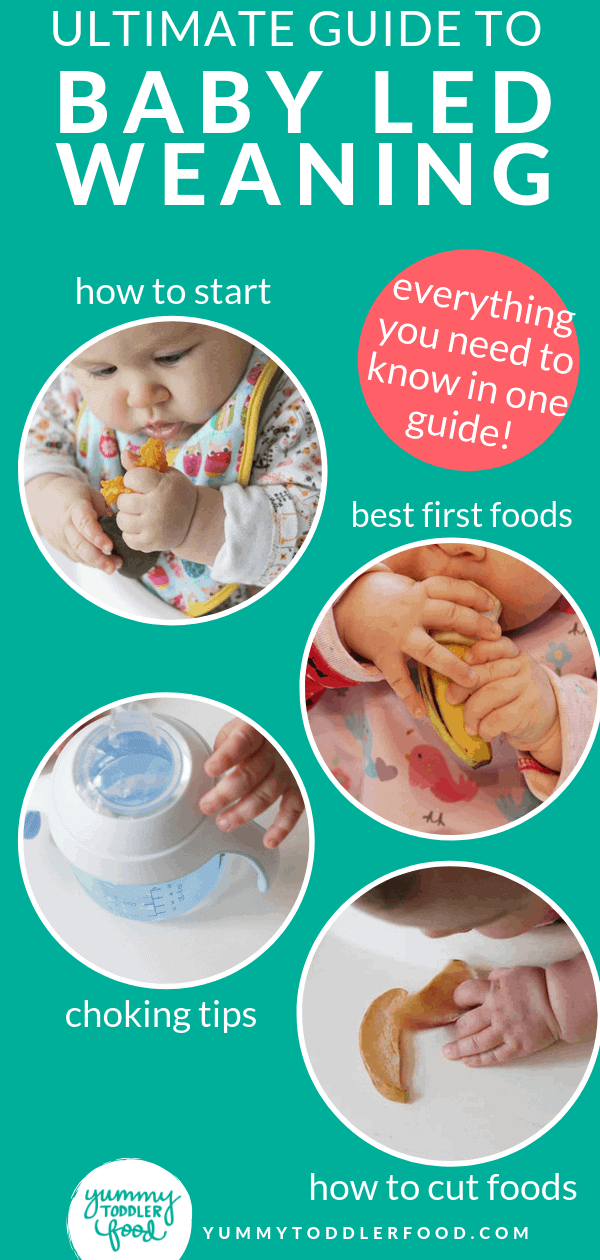
Learn the basics of how to do the feeding approach known as "baby led weaning" and the best first foods for baby to make starting solids easy and fun. Plus: Learn why it's perfectly okay to use a combined approach of blw and purees.
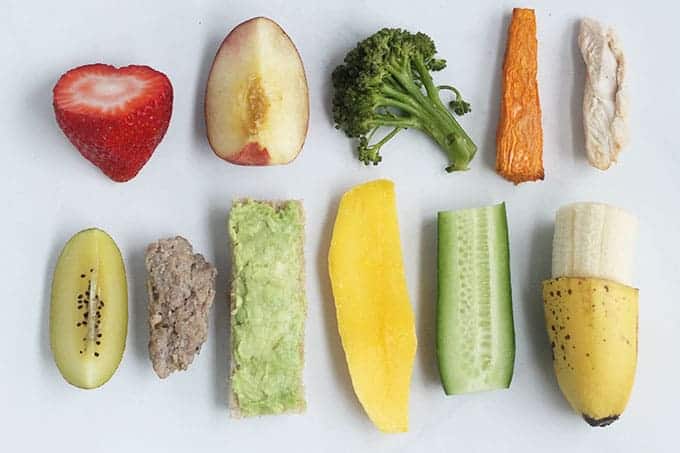
Baby Led Weaning
The feeding approach known as "baby led weaning" or "BLW" for short, is a style of feeding infants that allows them to feed themselves right from the start. The food is offered in thick finger-size pieces and is soft and easily squishable between your fingers. This way, the food is both easy to hold but has a low risk of choking.
TIP: This method became popular about a decade ago after the publication of the Baby Led Weaning: The Essential Guide to Introducing Solid Food by UK author Gill Rapley.
BLW Baby
One of the many reasons that people are starting to opt for this style of feeding more and more is simply that it's easy. In many cases, you can modify foods you're already making to share with your baby and there's not always a lot of separate cooking involved. It also allows a baby to have control over what goes into their mouths, which sets a good precedent for letting them eat intuitively from the start.
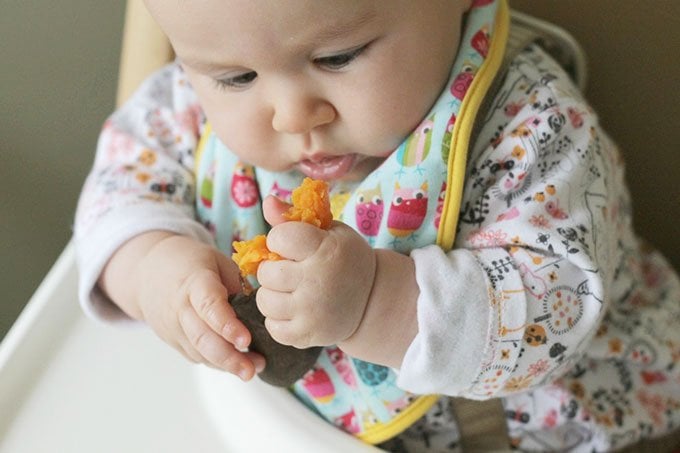
What age should I start baby led weaning?
According to the American Academy of Pediatrics, a baby is ready to start solids with baby led weaning when:
- They've doubled their birth weight (at least).
- They can hold their head up well and are starting to sit up unsupported.
- They show signs of being interested in food (watching you eat, reaching for food when you're eating, etc).
- When you feed them, they are able to move the food around in their mouths—rather than spit it right out.
TIP: Look for a highchair that allows a baby to sit up relatively straight so they can have good posture and better control over their arms and hands.
How to Start Baby Led Weaning
The first time you offer solids is such a fun milestone, so you'll be ready once you follow these simple steps.
- Make sure baby has hit the milestones listed above to let you know that he's ready to start.
- Get the highchair ready and adjust the straps and foot rest as needed.
- Plan to introduce water when you start solids. I recommend a trainer cup.
- Choose one food to start with and plan to offer only one food at a time.
- Stop when baby starts to fuss, turns his head away, or shows any other signs of not wanting to continue. It's usually fairly obvious when they are done!
TIP: If you start offering solids and baby just doesn't seem interested at all, it's okay. Take a break for a few days or a few weeks and start again. Each kiddo has their own unique timeline.
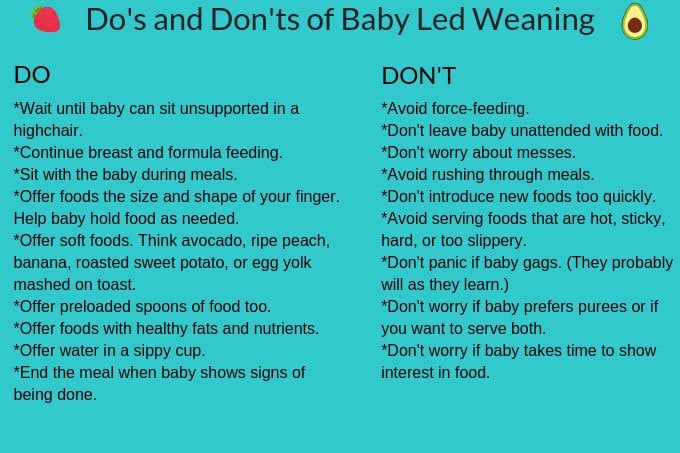 Best Tips for Starting BLW
Best Tips for Starting BLW
Here are a few more tips to consider and review before you get started.
- Understand the gag reflex. Gagging is different than choking though and is most often a sign that baby is learning to move food around in their mouths—and to get it out of their mouths, which is a skill you want them to have!
- Brush up on the basics of how to know when baby is ready to start solids. (Go back to the top of this post for the signs to look for.)
- Set them up for success with a highchair that allows them to sit up straight and has foot support.
- Sit with them as you offer food.
- Check your own expectations of what will happen and simply allow your baby to take the lead.
- Start with one new food a day or every few days.
- Vary the textures of foods you offer to start exposing baby to many right from the start.
- Offer water in a sippy cup or small open cup.
TIP: Remember that breastmilk or formula will continue to satisfy baby's hunger for the first few months of eating solids. Do not expect solids to replace milk feedings at this age.
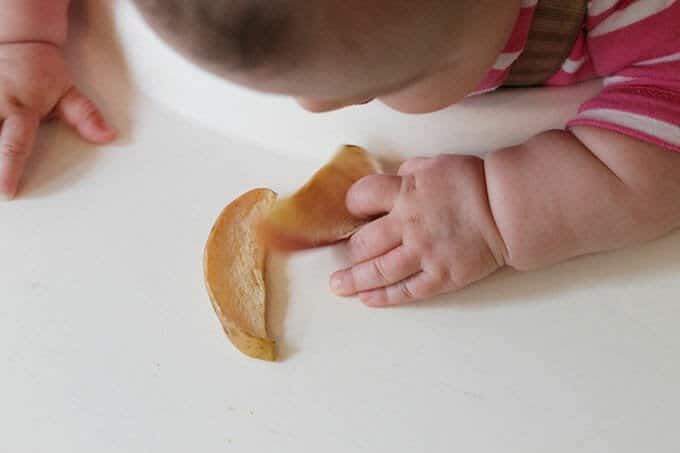 First Foods for Baby
First Foods for Baby
Starting solids with baby led weaning or purees are both perfectly acceptable ways to introduce a baby to solid foods—but the topic can get so heated! There's a lot of pressure to do it the "right" way and I'm here to say that there isn't one. You 100% can do one or the other, or combine the two to make it work for your family. It's all good!
Remember, the goal with first foods for baby is that they're introduced to flavors, nutrients, and foods they can easily eat or suck on. It should be an enjoyable milestone for all involved.
TIP: It's a good idea to get into the habit of offering an iron-rich food since iron stores in babies start to run out around 6 months and they'll need to start ingesting it in their food.
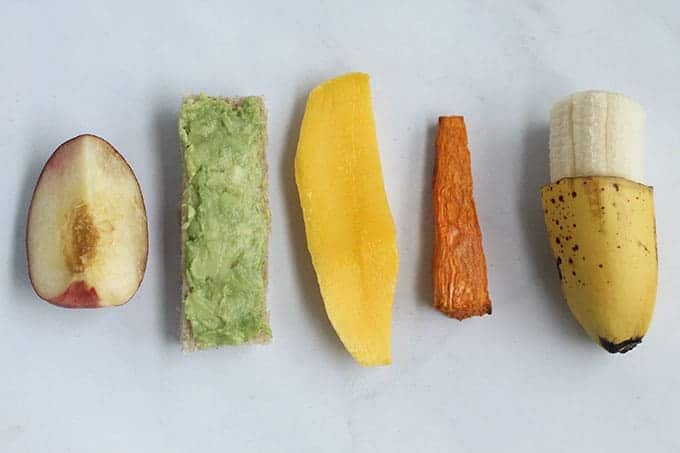
Best First Foods for Baby Led Weaning
Here are some of our favorite first foods to offer baby led weaning style. You want foods to be finger sized so they are large enough that baby can't force the whole piece into their mouth, and a shape that's easy for a 6 month old to hold with their chubby little hands. These are some of our favorites.
- Roasted sweet potato wedges
- Roasted apple wedges, skin on to help them hold together
- Roasted or steamed broccoli florets (big enough for baby to hold)
- Melon slices
- Thick mango slice
- Banana with some of the peel still on
- Toast sticks with mashed avocado
- Avocado spears (make sure the avocado is ripe and soft)
- Lamb or beef, on the bone or a large piece for baby to suck on
- Dark meat chicken, on the bone or a large piece for baby to suck on.
TIP: The foods should generally be soft enough to squish between your fingers with the exception of the large pieces of meat. If baby gnaws a piece down into a smaller piece, replace it with a larger one to avoid her putting a chunk of food into her mouth.
 Baby Led Weaning Banana
Baby Led Weaning Banana
To serve a banana to a baby, wash it well, then slice it in half. Cut off an inch or two of the peel, but leave the rest of the peel on so it's not slippery for baby to hold. They'll suck on the top part like a little popsicle! You can also help them hold the banana if needed.
Foods to Avoid Serving While Doing BLW
You want any foods you offer to a baby while doing baby led weaning to be soft enough to squish between your fingers and safe for them to eat and digest. Plan to avoid:
- Anything hard, sticky, or crunchy (like raw apple or carrot, whole nuts, crackers, or a big spoonful or nut butter)
- Added salt
- Cow's milk (which is difficult for kids under 1 to digest; plain yogurt is fine though)
- Added sugar (they simply don't need it)
- Honey (to avoid a risk of botulism)
- Super slippery foods that would be hard for baby to hold (which can be frustrating)
TIP: Always sit with your baby and watch them try to eat. They are your best guide for making adjustments to the foods you serve.
Baby Led Weaning and Choking
There are many parents who dislike this method of feeding because it often sounds like a baby is choking. And while there are surely some incidences of choking, what's more likely is that a baby will occasionally gag on a piece of food that gets into their mouth that they weren't expecting.
But remember: Gagging is a sign that baby is doing what she needs to in order to move the food around in their mouth as they learn to eat. It usually sounds more dangerous than it actually is.
TIP: If the sound of gagging really freaks you out, you're not alone. Consider offering more preloaded spoons with purees to start your journey more slowly.
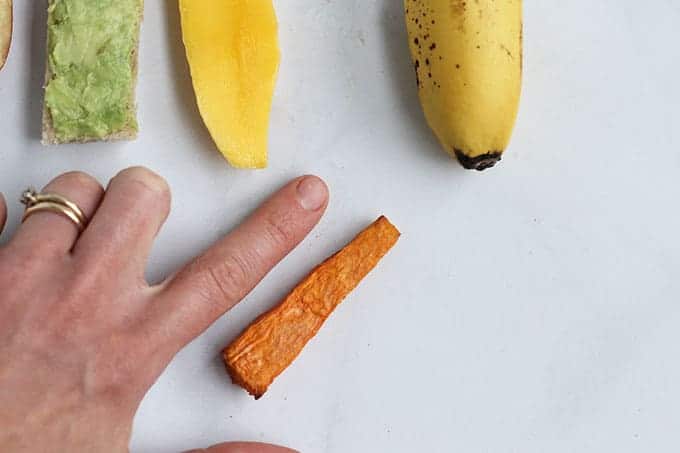 How to Cut Foods for BLW
How to Cut Foods for BLW
You generally want the food to be big enough that it would be difficult for baby to put the entire thing into their mouths. Here are some specifics:
- Foods that are roughly the size of a finger, so about a 4-inch stick.
- Foods that are easy for the baby to pick up—they can't pick up small pieces until closer to 9 months when they develop the ability to use their fingers in what's known as a "pincer grasp".
- Foods that aren't too slippery—so you can wash and leave some of the peel on fresh foods like bananas, avocado, kiwi, and mango.
TIP: You can also go even bigger if you're worried about size. Think half of a slice of bread or a big chunk of watermelon.
Will my baby actually eat much food with BLW?
Probably not at first. There will likely be more tasting of the food than eating of it and that is totally fine. They will still rely on breast milk or formula at this age for their main nutrition, so don't expect them to suddenly start eating full meals. (They'll get there in a few months, but it takes time!)
Do babies need teeth for baby led weaning?
No! Gums are super strong and front teeth aren't used for chewing—that happens when the back molars come in. Teeth really have nothing to do with whether or not a baby can eat solids.
TIP: Learn more about what to expect from teething here.
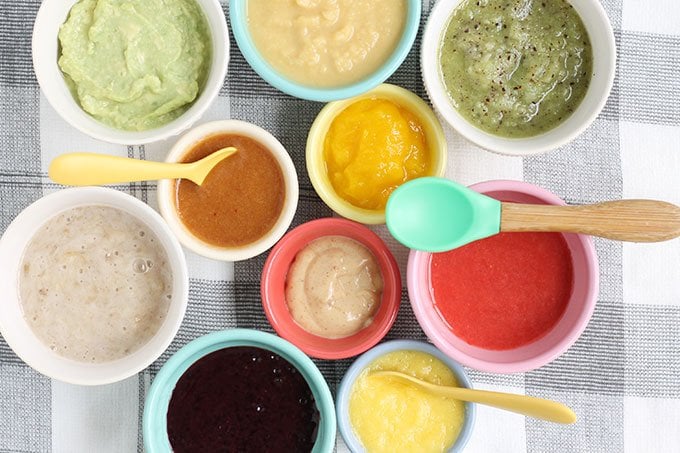
Can you mix baby led weaning and purees?
Absolutely! I think it's a great idea to mix the two methods simply because it gives you many more options for foods and allows the baby to experience more textures. I recommend allowing babies to feed themselves preloaded spoons—so you put the puree on a spoon, then hand it to them to actually put the spoon into their mouth—so they still have control over what goes into their mouths.
TIP: Feeding some purees is also helpful if you'll be sending food with a baby to daycare since the care provider may not have experience with blw.
Best First Foods for Baby: Purees
Here are some of our favorite purees to start offering baby when they're ready to start solids. Remember: There's no evidence that says that you need to start with vegetables versus fruits, so go with something that tastes good to you. Start with single foods pureed smooth and offer just a little at a time on a spoon.
- Mashed roasted sweet potato puree
- Mashed avocado puree
- Mashed banana puree
- Butternut squash puree
- Applesauce, unsweetened
- Mashed pea puree
- Oatmeal baby cereal (with added iron)
TIP: One of my favorite baby food companies is Amara Organic Baby Food, a company using a nutrient protection technology that makes organic purees just as good as homemade. I love how easy they are to use when I need a shortcut and that they have fun baby-led weaning recipes on the side of every box! (paid affiliate link)
How do I know when baby has had enough?
If your baby is eating and then starts to turn her head away or just refuses to open her mouth, she's done! Babies may also start to fuss if they've had enough. Learning this new skill takes time and babies can become tired fairly quickly into the process, so don't expect them to always eat very much or to last very long at the table. This stage is about exploration!
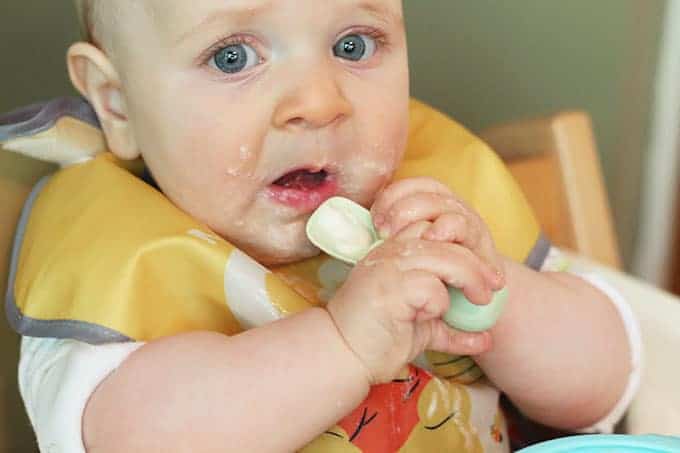
Baby with preloaded spoon of yogurt
How to Let Baby Self Feed Purees
I love offering purees on a preloaded spoon. To do this, the parent, puts some of the food on the spoon and hands it to baby. Then baby can bring the food to their mouth all by themselves. This gives you some of the same advantages of baby led weaning, but can be more comfortable for many parents.
Remember, you can mix what you offer, going back and forth between purees and blw finger foods, so you can offer the same food two different ways to let baby explore. The main goal is to avoid forcing baby to take more bites than they want to, which can sometimes happen with purees.
When to Introduce Potentially Allergenic Foods
In recent years, guidelines have been updated on when to introduce potential allergens including peanuts, eggs, and shellfish, so unless you have a family history of a food allergy, you can go ahead and introduce them soon after baby starts eating solids. In fact, research is showing that introducing these foods early can actually protect baby from developing an allergy. Talk to your pediatrician if you have concerns.
TIP: Thin unsweetened peanut butter with water to form a very thin Peanut Butter Puree until it's about the consistency of regular yogurt and offer a very small amount on a spoon or spread on a toast stick.
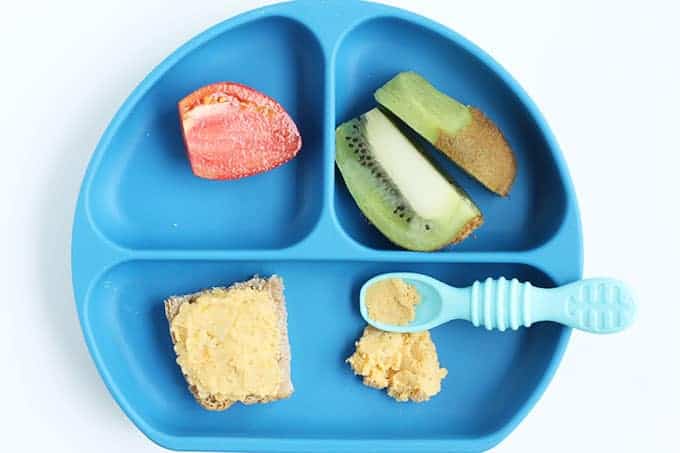 What does a baby led weaning meal look like for months 7 and 8?
What does a baby led weaning meal look like for months 7 and 8?
Until a baby is closer to 9 months and is able to pick up smaller pieces of foods, but after they have gotten the hang of one food at a time, I try to offer 1-2 foods they can feed themselves and one puree. This offers them a chance to ingest more via the puree but still feed themselves a range of textures. You can do more or less food following the lead of the child.
TIP: My Baby Food Chart has loads of with ideas for blw foods and purees by month.
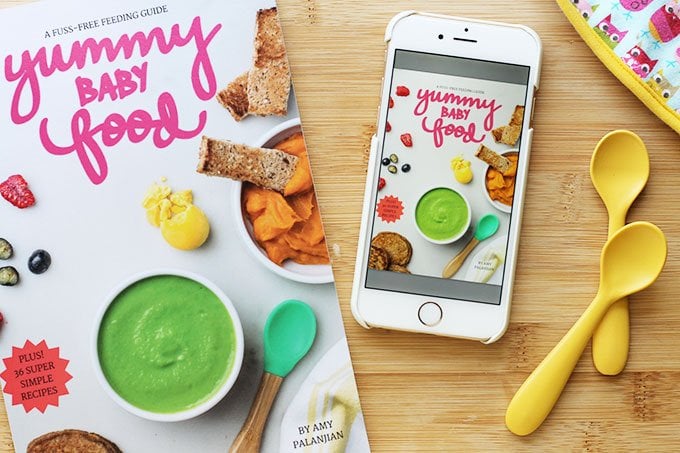
Recipes for Every Stage of Starting Solids
If you're ready to start solids with baby, or you're just curious what it looks like to do a mix of baby led weaning and purees, check out my Yummy Baby Food cookbook. It goes stage by stage with specific foods to start in each, with simple recipes and easy feeding tips.
Listen to a recent podcast episode to hear about some of the basics of BLW with our guest Megan McNamee, MPH, RDN, CLT, and a Registered Dietitian Nutritionist specializing in pediatric nutrition who runs Feeding Littles.
I'd love to hear any questions you have with BLW or if your baby had a first food that I didn't list here. Please comment below to share your experience!
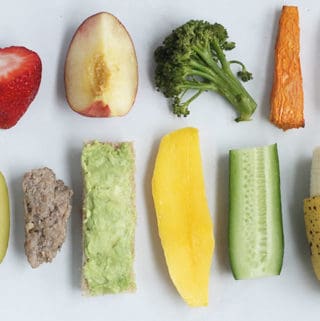
Ultimate Guide to Baby Led Weaning (and Best First Foods)
Below are some of the best first foods to start baby led weaning. Choose one at a time to offer and make sure that the fruits are ripe so that they are soft and taste good. (Nutrition will vary based on the specific foods you offer.)
Prep Time 5 mins
Total Time 5 mins
Course Dinner
Cuisine American
Servings 1
Calories 28 kcal
Banana
- 1 small ripe banana with peel on
Roasted Sweet Potato
- 1 small sweet potato + 1 teaspoon olive oil
Roasted Apple
- 1 small apple + 1 teaspoon butter or neutral oil
Roasted Broccoli
- 1 cup broccoli florets + 1 teaspoon olive oil
Sauteed Green Beans
- 4 green beans 1 teaspoon olive oil
Melon
- 1 small piece watermelon or cantaloupe
Avocado Toast
- 1 slice whole grain bread
- 1 tbsp ripe avocado
Avocado Spear
- ⅛ ripe avocado
Lamb or Beef
- 1 lamb chop, roast, or steak
Pan-Seared Chicken Thighs
- 1 chicken thigh
- 1 tsp olive oil
- 1 garlic clove, optional
Banana with some of the peel still on
-
Cut a banana in half. Use a knife to gently cut around the peel about 2 inches down, leaving some of the peel on so that the banana is easy for baby to hold and less slippery.
Roasted Sweet Potato Wedges
-
Preheat oven to 400 degrees and line a rimmed baking sheet with foil. Wash and dry the sweet potato. (You don't need to peel it.) Cut in half, then cut lengthwise into strips. Cut each strip in half again until each is about 1/2-inch thick. Slice in half horizontally if the sweet potato is very long. (Each strip should be about the size of your finger.) Place into a bowl and toss with the olive oil. Spread onto prepared baking sheet and roast for 22-25 minutes or until soft. Let cool slightly and serve.
Roasted Apple Wedges
-
Preheat oven to 375 degrees F. Place the butter or oil into a pie plate or baking dish. Warm in the oven for a few minutes to melt. Remove from oven. Slice the apple into approximately 1/2-inch slices and discard the core. Place into the baking dish with the oil and toss to combine. Add cinnamon if desired. Bake for 28-34 minutes, or until tender when poked with a fork.
Let cool slightly and serve.
Roasted Broccoli Florets
-
Preheat the oven to 400 degrees F. Place the broccoli onto a rimmed baking sheet and toss with the olive oil, coating and mixing well until all of the florets are a little shiny and coated with oil. Roast for 15-18 minutes or until tender. Let cool slightly and serve.
Sauteed Green Beans
-
Warm the oil in a large skillet over medium heat. Add the green beans and stir. Cover and cook for about 8 minutes. Remove cover and taste one to see if it's soft enough. Cook for an additional minute or two as needed.
Melon slices
-
Cut into a thick stick or a wedge and offer to baby.
Avocado Toast
-
Mash the avocado very smooth with a fork. Spread a thin layer onto a toast stick and serve.
Avocado Spears
-
(Make sure the avocado is ripe and soft): Cut a thick strip of avocado and offer to baby. You can leave the peel on if that makes it easier for baby to hold (just wash it first).
Lamb or Beef
-
Prepare a roast, steak, or chop without salt and with butter or olive oil until cooked medium well. Offer a thick slice at least the size of your finger or a drumstick.
Pan-Seared Chicken Thighs
-
Warm 1 tablespoon olive oil or butter in a large skillet over medium heat. Add the chicken thigh and top with a few slices of fresh garlic, if desired. Cover and cook for 4-5 minutes. Remove cover. Flip over and cook for an additional 4-5 minutes uncovered or until a meat thermometer registers 165 degrees F.
- Add spices like garlic powder, cinnamon, cumin, oregano, or any other non-spicy flavor you like to make these more interesting.
- Offer just one piece at a time when starting out.
- If baby gnaws a piece down into a smaller piece, replace it with a larger one to avoid her putting a chunk of food into her mouth.
- Store any leftovers in an airtight container in the fridge for 3-5 days. Reheat briefly if needed.
- Remember that it's normal for babies to take time to actually ingest the food. Part of the process is exploring all of the senses related to the experience of eating.
Calories: 28 kcal Carbohydrates: 2 g Protein: 1 g Fat: 2 g Saturated Fat: 1 g Polyunsaturated Fat: 1 g Monounsaturated Fat: 2 g Sodium: 6 mg Potassium: 75 mg Fiber: 1 g Sugar: 1 g Vitamin A: 23 IU Vitamin C: 2 mg Calcium: 2 mg Iron: 1 mg
Keyword baby food, baby led weaning foods
Rate in the comments and tag @yummytoddlerfood on IG!
Filder Under:Baby Food, Podcast, Starting Solids
Best Foods for Baby Led Weaning 7 Months
Source: https://www.yummytoddlerfood.com/first-foods-for-baby/
0 Response to "Best Foods for Baby Led Weaning 7 Months"
Post a Comment